Abstract
Recently, there has been an increasing interest in sustainable design to improve and treat interior space to reduce pollution and protect the environment. Given the global trend towards increasing the ability of interior design elements to adapt to environmental conditions to improve the efficiency of interior spaces, we found it important to conduct a study on the development of interior design for classrooms in the Art Education Department at the College of Education at King Faisal University. This study aimed to reveal the reality of classrooms in the Art Education Department and reach a proposed vision for designing classrooms to achieve environmental sustainability in the Art Education Department at King Faisal University. This study used the descriptive survey method and the descriptive analytical method due to their suitability for this study. The study sample consisted of approximately 100% of faculty members and 100% of students in the Art Education Department at King Faisal University. The results showed that the design standards required to be achieved to create environmental sustainability in the classrooms of the Art Education Department at King Faisal University from the point of view of faculty members and students were only slightly appropriate, and there was a noticeable agreement by the arbitrators specialized in the field of design and arts that the proposed concept for designing classrooms to achieve environmental sustainability was highly acceptable.
1. Introduction
The Kingdom of Saudi Arabia is one of the most environmentally challenged countries in the world. Its climate is characterized by semiarid to arid desert, which causes water scarcity and sharp temperature differences with low rainfall in winter and extreme temperatures in summer. These harsh conditions have contributed to imposing economic and environmental challenges in total dependence on energy consumption produced from non-renewable natural resources, as energy demand is estimated to reach 120 gigawatts by approximately 2050. This increasing demand requires eight million barrels of oil per day to produce energy [1]. This creates the need to build a clean future by providing an integrated city in its housing and all its institutional buildings that are designed to reduce the environmental impact and consumption of natural resources and to reduce the damage resulting from water, air, and energy pollution [2], with attention to the sustainable design of educational institutions that play a role in driving the economy and advancing society in addition to their effective role in evaluating and correcting actions and spreading awareness related to the environment, its systems, and requirements. Education is important for developing any country and driving the wheel of progress in it. University institutions occupy a prestigious position in the education system. By their position, they are considered responsible for developing themselves, in addition to their responsibility for developing the design of the educational environment, which is part of that system because of its clear impact on the success of the learning and teaching process, as it contributes significantly to raising the effectiveness of the educational process or weakening its return and prepares a highly efficient, educated generation, by focusing on developing its educational spaces and designing classrooms according to the concept of sustainable interior design. Sustainable interior design is considered important, and there is an increasing global trend towards the need to achieve sustainability in all fields, at all levels. Achieving sustainable interior design is linked to the environmental, social, and economic requirements of humans. It also aims to create a management based on the efficient use of environmental resources in a sustainable manner, aims to reduce the negative impacts on spaces, through the efficient use of energy and resources, and achieves continuous efficiency in the relationships between the spaces used and the movement paths within the spaces [3].
Sustainability refers to the continued interaction between society and the ecosystem. It is a concept that calls for concern for the human future and the preservation of the environment, which provides continuity for humanity and enhances life in a way that allows others to meet their needs in the present and future. This concept can be applied to all designs, planning, and economics. Sustainability is using natural resources in the best possible way while preserving and maintaining them [4].
Based on the previous definition, and other definitions researchers have examined, it can be operationally defined as focusing on the elements and concepts of a healthy environment, which aims for long-term interaction between humans and their environment, protecting the planet, avoiding the depletion of natural resources, and reducing the impact of their use. This is achieved by creating an integrated, high-quality environment that preserves human health, meets human needs, and maintains the sustainability of the environment.
One modern design trend is sustainable interior design concepts in interior design treatments. These concepts tend to increase the interior design’s ability to adapt to environmental conditions and meet human needs, while conserving energy resources. It improves the efficiency of interior spaces through sustainable interior design aspects such as the selection of sustainable materials, energy efficiency based on utilizing natural lighting and energy-saving LED lighting, and water efficiency. This also includes improving indoor air quality and incorporating indoor plant elements into built environments to purify the air and focusing on health and psychological comfort [5]. This helps fine arts students develop their talents, employ their creative energies in the right place, and transform them into creative spaces that make them feel confident and emotionally secure and help them think and contemplate; it also meets their needs and provides them with the best quality for an enriching educational environment that promotes the educational process and achieves the desired educational success.
Activating sustainable interior design in the university community seeks to achieve a unified vision: to build a sustainable educational environmental future that is based on meeting the needs of the current generation without affecting future generations in meeting their needs in their time, and in addition to that, meeting their needs improves their productivity and takes into account their cultural requirements [2], which combines achieving economic development and preserving the environment in a single priority. It is an inspiring Saudi vision to raise the quality of life and protect the future of the Kingdom. This is what the universities of the Kingdom of Saudi Arabia in general strive to achieve when developing and improving the design of classrooms, using sustainable interior design standards and elements. King Faisal University, in particular, as one of the universities that has made efforts to combat climate change and solve pollution problems, contributed to the formation of a sustainable university community through practices such as saving electricity and replacing lighting bulbs with low-consumption lamps (LED) and using renewable energy and optical and kinetic sensors and through various activities to encourage university employees to rationalize energy use and use clean means of transportation within the university campus. Sustainable interior design aims to achieve sustainability in the use of environmental resources to reduce the negative impacts on interior spaces and to create healthier environments while reducing the use of environmental resources and energy. Using sustainable interior design concepts consist in meeting human needs in a way that conserves energy and resources and improves the efficiency of spaces, by achieving energy efficiency and employing renewable energies to acquire maximum benefit. Incorporating natural processes into the design, such as natural lighting and ventilation, and choosing materials and construction techniques that reduce indoor air pollution and gas emissions help achieve sustainability [6]. Furthermore, achieving energy savings and improving the efficiency of spaces economically, environmentally, and socially by providing an interior environment with good environmental specifications and low economic cost result in long-term products that do not require maintenance and replacement [7].
King Faisal University also worked to preserve water resources by establishing research centers related to water resources in terms of their source, quantity, and type, directing students not to waste water, treating wastewater and using the treated water to irrigate plants, and by otherwise promoting the conscious use of water on campus [8]. Accordingly, the current study came as a scientific attempt to study the reality of classrooms in the Department of Art Education at the College of Education at King Faisal University in light of the design standards for environmental sustainability; to determine the design standards that must be achieved, in addition to providing sustainable psychological and physiological needs, to create ecological sustainability in classrooms in the Department of Art Education, in order to present proposals and recommendations on the importance of the role of applying sustainable design in educational buildings, especially in classrooms in the Department of Art Education; and to raise awareness of sustainable design, its importance, and its role in providing an enriching educational internal environment that is environmentally friendly, which helps with comfort, creativity, innovation, and enjoyment of the fruits of producing artistic works, to achieve an optimal education for students and improve their outcomes. This is one of the most important pillars of sustainable development for the Kingdom of Saudi Arabia’s vision 2030.
2. Literature Review
This section deals with previous studies related to the sustainable interior design and designing interior classroom environments. The studies are dealt with according to the chronological order of their conduct, starting with the most recent and going down to the oldest.
Terblanche and Khumalo (2024) aimed to determine how sustainable Biophilic Design in study spaces affected student productivity at the University of the Witwatersrand. The study used a mixed method by collecting and analyzing quantitative and qualitative data using observation and a questionnaire as a data collection tool. The study results concluded that sustainable Biophilic Design helped improve student productivity, enhance their academic performance, and increase their mental and physical health when studying in those spaces [9].
Shams et al. (2023) [10] aimed to present a future vision for sustainable interior design for design halls in the faculties of arts. The descriptive analytical approach was used to achieve environmental, economic, and social standards through designs that supported a set of functions, re-structuring, and computer programs to confront climate fluctuations and reduce the consumption of nonrenewable energy. The study achieved several results with the most important being the development of classroom spaces in faculties of arts that depended on the optimal exploitation of renewable energy resources, achieving design flexibility, and obtaining quality and sustainability.
Ramadan (2022) [11] aimed to highlight the importance of the interior design of drawing rooms in the success of interior spaces in performing their tasks. The study and the descriptive analytical approach were used to describe the drawing rooms qualitatively and quantitatively and to present a set of proposed design solutions for a group of drawing rooms. The study obtained several results, reaching a set of design proposals for the drawing rooms at Al Shorouk Academy so that they achieved the aesthetic and functional aspects, which helped students to be creative and perform the required academic tasks with high efficiency.
Shaqour (2022) [12] aimed to determine the degree of student satisfaction with the design of the architecture studio in the Department of Architecture at Al-Nahda University, which affected the quality of the internal design environment. An inductive approach was used; the study created a questionnaire to diagnose students’ opinions in a specific case study. The study concluded that it was necessary to link students’ creativity to the educational environment. The result showed the effect of the design studio on students’ psychology and performance, which can be considered during the design process.
Al Najadi et al. (2019) [13] aimed to highlight sustainable design and its impact on the quality of the indoor environment for interior design. A descriptive analytical approach was used through a descriptive study of sustainable design, its principles, and standards, with an analysis of some sustainable materials. The study results showed that the concentration levels of most pollutants inside buildings were often about two to five times higher than their concentration levels in the outdoor air, such as wood, which is chemically treated with highly toxic materials. Sustainable interior design requires compatibility with the environment to achieve indoor environmental quality.
Al-Eisawi (2020) [14] aimed to identify the design requirements and considerations that must be taken into account in classrooms to develop the concepts and considerations that optimized the quality of these educational spaces. Using the descriptive analytical approach, the study reached several results, the most important of which were providing the necessary natural lighting through the proper orientation of the building, with the need for artificial lighting in some classrooms according to the orientation, and using thick walls with large thermal storage, which makes them retain heat in winter and coolness in summer.
Abdul Rahman et al. (2018) [15] aimed to apply sustainability and environmental standards and requirements in the interior design of school buildings and to produce a generation with rational behaviors towards the environment. The research used the descriptive analytical approach, and the study recommended the use of environmentally compatible materials and raw materials in floors, paints, and furniture, which can be recycled and are made of natural, nontoxic materials, good design for natural lighting, the use of energy-saving artificial lighting, and the use of smart lighting systems to achieve the highest quality of lighting.
Ahmed (2014) [16] aimed to create an ideal and integrated environment, serving students in design studios, identifying the requirements for designing the educational environment, and highlighting the role of interior design in developing and improving the design studio environment. The study used the descriptive analytical approach and the experimental approach. It produced several results, the most important one being that environmental elements have a positive impact on design studios.
Lee et al. (2012) [17] aimed to investigate the relationship between indoor environmental quality and learning performance in air-conditioned university classrooms through subjective assessment and objective measurement, along with data on temperature, relative humidity, air velocity, average radiant temperature, carbon dioxide concentration, and sound pressure. The study results found that thermal comfort, indoor air quality, and visual environment were equally important, and indoor environmental quality had an impact on learning performance.
This study reviewed several local, Arab, and foreign studies that dealt directly or indirectly with sustainable interior design of the physical environments of various universities, within the period from 2011 AD to 2024 AD. These studies included several countries and nations, indicating their temporal and geographical diversity, and their results contributed to enriching the current study scientifically about the subject of sustainable interior design and the development of classrooms for various fields of arts, setting the general theoretical framework for the study and helping frame its results.
Similar to some previous studies, we used the descriptive analytical approach as the appropriate approach for human studies and selected the sample accordingly. We also used questionnaires as a tool for collecting data from study individuals. We agree with previous studies on the importance of sustainable interior design and the importance of developing the design of the interior environment and its impact on students. We also hope that the current study will constitute a scientific addition to the literature in the field of sustainable interior design and highlight the importance of the role of applying sustainable interior design as part of developing and improving the design of classrooms in the Department of Art Education, and its effects on students. This study presents a design proposal for classrooms by providing a sustainable enrichment educational environment based on the use of environmental materials in interior design treatments to reduce pollution and protect the environment in addition to providing an internal climate that helps creativity, innovation, and access to the optimal education for students in order to raise their academic level, which will enable King Faisal University in Al-Ahsa Governorate in particular and the universities of the Kingdom of Saudi Arabia in general to develop and improve the design of classrooms in their various artistic specializations, using the standards and elements of sustainable interior design as an introduction to an enriching educational environment.
3. Problem Statement
The global trend towards applying sustainable interior design is increasing the efficiency of interior design elements to adapt to environmental conditions that meet human needs and improving the efficiency of interior spaces from a design perspective. Hence, we recognized the importance of conducting a study on developing the interior design of classrooms in the Department of Art Education at the College of Education at King Faisal University, as a physical environment in educational institutions that has an effective role in the success of the educational process. The results of previous studies confirmed this, revealing that the interior design of art halls affects teaching practices, educational activities, their effectiveness, and student interaction. Therefore, they must be developed and reshaped through sustainable interior design and the optimal utilization of renewable energy resources. Accordingly, the current study sheds light on the design of the reality of the Department of Art Education classrooms. To determine the design standards that must be achieved to create internal environmental sustainability compatible with the various artistic fields taught in the department, classrooms are the focus of the educational process and one of the most important factors that affect students and their academic achievement. Therefore, the current study aims to reveal the sustainable design of classrooms as an introduction to an enriching educational environment for students of the Department of Art Education at King Faisal University as a model.
The importance of the current study is as follows:
- -
- Theoretical importance:
The importance of the current study is due to the global trend towards sustainable interior design and its role in providing a healthy and comfortable interior environment for users of the interior space, especially its importance in meeting the needs of the present without compromising the ability of future generations to meet their own needs, as well as keeping pace with trends calling for the application of sustainable interior design in university educational buildings.
- -
- Practical importance:
The Ministry of Education has sought to achieve the Kingdom’s vision for sustainable development by addressing the requirements of the present generation without threatening the opportunities of future generations, providing to their needs. This allows the economy to flourish, generations to be built, and the quality of life to improve without compromising environmental resources. Moreover, it allows the Kingdom to achieve the desired academic progress in its education [18]. Activating sustainable interior design in educational buildings is a must in light of the increasing environmental challenges in the Kingdom of Saudi Arabia, as it also has a significant impact on the level of comfort of the occupants of the space, their emotions, behaviors, and performance, in addition to their general physiological and psychological health and well-being [19,20]. The current study focused on the reality of the current interior design of classrooms to reveal its strengths and weaknesses, investigate them, and try to address them by presenting a sustainable design proposal in addition to motivating interest in applying sustainable interior design in university classrooms for teaching various fields of design and arts, due to its role in preserving the environment and people, economic prosperity, and societal progress.
4. Study Objectives
The current study aimed at the following:
- -
- Reveal the reality of design standards in classrooms in the Department of Art Education to achieve environmental sustainability in these classrooms.
- -
- Determine the design standards that must be achieved to create environmental sustainability in classrooms in the Department of Art Education.
- -
- Meet the psychological and physiological needs of users of these classrooms.
- -
- Reach a proposed vision for designing classrooms and suggest design standards to achieve environmental sustainability in classrooms of the Department of Art Education.
5. Study Limits
- -
- The current study was limited to the following boundaries:
Objective limits: the current study was limited to sustainable interior design from the following aspects: revealing the reality of classrooms, determining design standards, providing psychological and physiological needs, and reaching a proposed design vision to achieve environmental sustainability for classrooms in the Department of Art Education at the College of Education at King Faisal University.
Time limits: the study was applied in the first semester of the academic year 2023–2024 AD.
Spatial limits: the study was applied to classrooms in the Department of Art Education at the College of Education at King Faisal University, in Al-Ahsa Governorate, Kingdom of Saudi Arabia.
Human limits: the study was limited to faculty members and student users of classrooms from the Department of Art Education at the College of Education at King Faisal University.
6. Study Questions
The current study sought to answer the following questions:
- What is the reality of the classrooms in the Art Education Department at King Faisal University in light of the design standards that must be achieved to create environmental sustainability in these classrooms?
- What are the design standards that must be achieved to create environmental sustainability in the classrooms in the Art Education Department?
- What psychological and physiological needs must be met in the classrooms?
- What is the proposed vision for designing the classrooms in the Art Education Department in light of the design standards necessary to achieve environmental sustainability?
7. Materials and Methods
- Study methodology:
The nature of this study required its reliance on the descriptive survey and analytical approaches.
- -
- The descriptive survey approach: The descriptive survey approach was used, due to its suitability for this study, by designing an electronic questionnaire to reveal the reality of the current design of classrooms as an introduction to an enriching educational environment for students of the Department of Art Education King Faisal University as a model, by collecting real and detailed information from faculty members and students of the Department of Art Education, and formulating opinions and experiences to develop future visions and suggestions.
“The study was conducted in accordance with the Declaration of Helsinki, and the protocol was approved by the Ethics Committee of the Research at King Faisal University (KFU–REC–2022–SEP–ETHICS69) on [13/09/2022]”.
The descriptive survey approach is “that type of study through which all members of the research community, or a large sample of them, are questioned; to describe the phenomenon studied” [21].
- -
- The descriptive-analytical approach: The descriptive-analytical approach was used by applying the correct considerations that the study reached, by presenting a proposed vision to design a set of classrooms in light of the design standards required to achieve environmental sustainability in the Department of Art Education at King Faisal University. The descriptive-analytical approach was chosen for its suitability for this study, as it relies on collecting detailed information about a phenomenon in a given society. It also aims to identify what individuals do about a problem and to leverage their opinions and experiences to develop appropriate solutions and plans.
This descriptive study approach is a type of quantitative or qualitative study that aims to describe phenomena as they exist in reality without interfering with or modifying them. It is widely used in educational, social, and psychological fields, and is useful for collecting rich data to understand the current situation. It was used because it was appropriate for the study problem. Its advantages included the following:
- -
- It monitored the current interior design of classrooms, making the results more relevant to the real context.
- -
- It used flexible tools such as questionnaires and observations based on the current design of classrooms.
- -
- It helped identify problems in the internal environment of classrooms that needed intervention or development, based on the opinions of faculty members and students. This helped develop design solutions based on a realistic understanding.
- The study community and its sample:
The study sample represented the percentage of responses from the study community among which the study questionnaire was distributed electronically. Due to the small size of the study community, the study relied on the comprehensive enumeration method, which was represented by all members of the community without exception, so that the number of members of the basic sample consisted of 44 male and female faculty members in the Department of Art Education at King Faisal University, which constituted about 100% of the original community. This study also relied on selecting a simple random sample of students of the Department of Art Education at King Faisal University due to the large size of the community, so there would be no bias in the selection. The number of members of the basic sample, which consisted of 136 male and female students with bachelor’s, master’s, and doctoral degrees, constituted about 100% of the original community.
- Theoretical Framework
Sustainable interior design is defined as shaping interior spaces through environmental treatments to reduce energy consumption and polluting emissions, the trend towards using renewable, environmentally friendly, and recyclable materials, and benefiting from environmental interior treatments that provide a safe and healthy environment for society. Accordingly, sustainable interior design plays an important role in society, as sustainable interior designs constitute an incentive for social change in response to community needs and in creating friendly spaces that help improve the health of interior space occupants, provide them with comfort and well-being, and also aim to preserve environmental resources that have social, cultural, material and economic impacts, including the ability to maintain the requirements of a healthy lifestyle and economy, as shown in Figure 1, and reduce global warming and toxic gas emissions. From this standpoint, attention has been paid to employing sustainable interior design as a cultural awareness of society to preserve the natural environment for current and future generations [22].

Figure 1.
The balanced and unbalanced economic system illustrates the society’s consumption of natural resources [23].
Environmentally friendly interior design is based on environmental design techniques through the application of sustainable strategies that are linked to the green building assessment system, which includes five environmental considerations, location, water, energy, materials, resources, and indoor environmental quality, particularly related to interior design for improving the efficiency of spaces by achieving energy efficiency and employing renewable energies and paying attention to the quality of the indoor environment and interior materials. The quality of interior materials includes reducing inputs, managing outputs, and designing the life cycle. The term input reduction refers to reducing the use of non-renewable resources such as electricity, water, and raw materials in interior materials. Output management is a process of minimizing negative impacts on the environment by producing less waste and managing it properly, such as reusing and recycling, which contribute to preserving natural resources [24,25].
- Sustainable interior design standards:
The standards for achieving sustainable interior design are multi-directional, due to their importance in finding ways to achieve a sustainable interior environment. Table 1 shows these standards.

Table 1.
Standards for sustainable interior design.
- Sustainable interior design in classrooms
Sustainable interior design in classrooms contributes to creating healthier and less environmentally harmful interior environments as it aims to reduce the negative impacts on interior spaces through the optimal use of energy. It achieves continuous efficiency in the relationships between the interior spaces used and the movement paths within the spaces and contributes to achieving a design that provides a high-quality interior environment suitable for users that encourages them to raise their performance efficiency and provides them with a healthy environment free of pollution, while reducing energy consumption and economic costs [26]. As one of the studies concluded in its results, sustainable interior design contributes to reducing annual energy consumption, which leads to a decrease in greenhouse gas emissions [27]. Moreover, renewable and natural materials should be part of the interior design treatments for classrooms to raise the level of connection with nature, so that students know the relationship between materials and nature and have an awareness of the importance of preserving the environment. There is no doubt that educating students about sustainable design will make them environmentally responsible, as one study emphasized its role “in raising community awareness of the role of sustainability as an influential teacher in interior design; to create a supportive general culture, and clarify the concepts and treatments of sustainable interior design as a step towards its social acceptance” [22] and providing ideal healthy educational environments for students and those in charge of them, therefore improving their performance. Thus, the importance of developing classrooms for students of the Department of Art Education leads to creating a healthy and inspiring environment for creativity to raise the educational level related to various fields of art through sustainable interior design.
- Sustainable interior design materials
They are defined as materials whose extraction, manufacturing, use, or the energy required to complete any of these stages does not result in harm to humans or the surrounding environment and which do not pollute the indoor environment because they are manufactured from natural materials. They can also be defined as materials that do not cause harm to the environment, whether in their production, use, or disposal, and can be easily recycled so that they aim to reduce the negative effects reflected on the environment and the consumption of natural resources. They aim to obtain a healthy environment between humans and their environment, where sustainable materials address environmental, social, and economic factors and depend on local, natural materials, and the effective and rational use of resources. These materials should be renewable and long term, recyclable and reusable, nontoxic, energy-efficient, and low cost as shown in Table 2 [15].

Table 2.
Shows some sustainable materials.
Table 2.
Shows some sustainable materials.
| N | Material Name | Description | Figure |
|---|---|---|---|
| 1 | Compressed-straw panel | It is a building panel made of compressed straw covered with recycled cardboard. It is a stable, easy-to-process, and sound-insulating material. | Figure 2 |
| 2 | Natural-straw fiberboard | Made from 100% straw, it is used in interior applications such as furniture making and interior construction and is characterized by being treated with organic waste [28]. | Figure 3 |
| 3 | Date palm fiber fabric | Date palm fiber fabric panels, a sustainable local material, enhance the sound absorption quality of interior spaces [29]. | Figure 4 |
| 4 | Date palm frond waste | A handmade material made by cutting palm frond branches into long pieces, then drying them and cutting them into pieces of equal length. These pieces are assembled, glued together, and used as an alternative to imported wood. | Figure 5 |
| 5 | Wooden newspaper papers | Material made from old newspapers pressed together using non-water-based glue. It is a sustainable alternative to wood, is lightweight, and is used in furniture pieces. | Figure 6 |
| 6 | Natural fiber panels | The figure shows a table made of natural fiber panels. This material is entirely based on renewable materials from agricultural waste and is made from 100% renewable raw materials using a bioplastic-based binding agent. The material is recyclable and biodegradable [28]. | Figure 7 |
| 7 | Bamboo | The figure shows a chair made of bamboo wood. Bamboo is a natural resource that is fast-growing, easy to regenerate, and lightweight [30]. | Figure 8 |
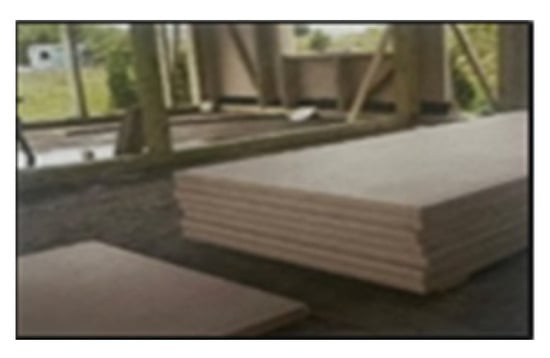
Figure 2.
Compressed-straw panels. It is a building panel made of compressed straw covered with recycled cardboard. It is a stable, easy-to-process, and sound-insulating material.
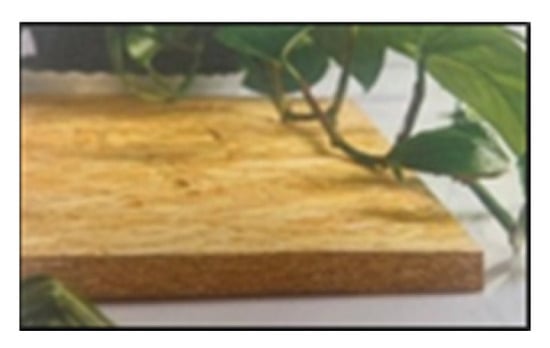
Figure 3.
Natural-straw fiberboards. Made from 100% straw, it is used in interior applications such as furniture making and interior construction and is characterized by being treated with organic waste [28].
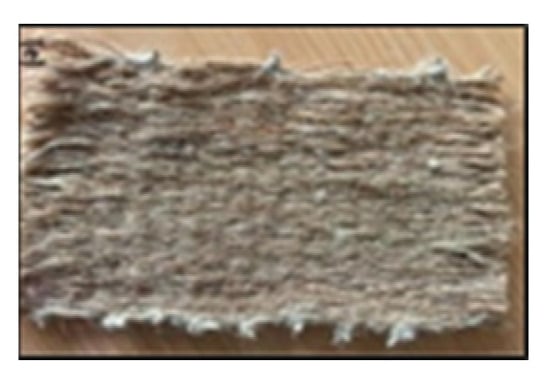
Figure 4.
Raw material of date palm fibers. Date palm fiber fabric panels, a sustainable local material, enhance the sound absorption quality of interior spaces [29].

Figure 5.
Raw material of date palm frond waste. A handmade material made by cutting palm frond branches into long pieces, then drying them and cutting them into pieces of equal length. These pieces are assembled, glued together, and used as an alternative to imported wood.
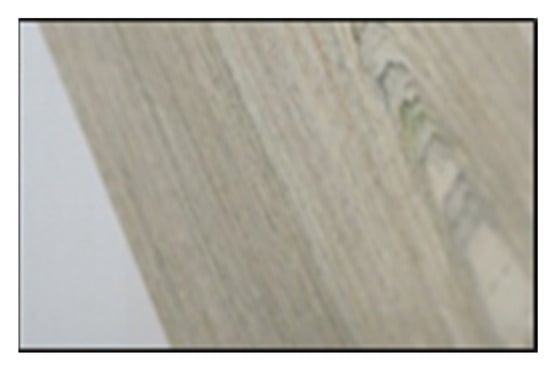
Figure 6.
Wood material made from newspapers. Material made from old newspapers pressed together using non-water-based glue. It is a sustainable alternative to wood, is lightweight, and is used in furniture pieces.
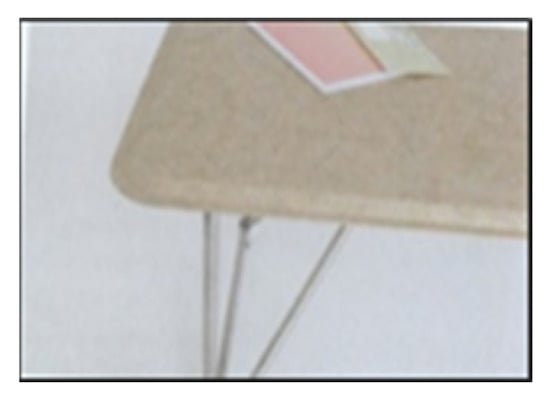
Figure 7.
Table made of natural-fiber panels. This material is entirely based on renewable materials from agricultural waste and is made from 100% renewable raw materials using a bioplastic-based binding agent. The material is recyclable and biodegradable [28].
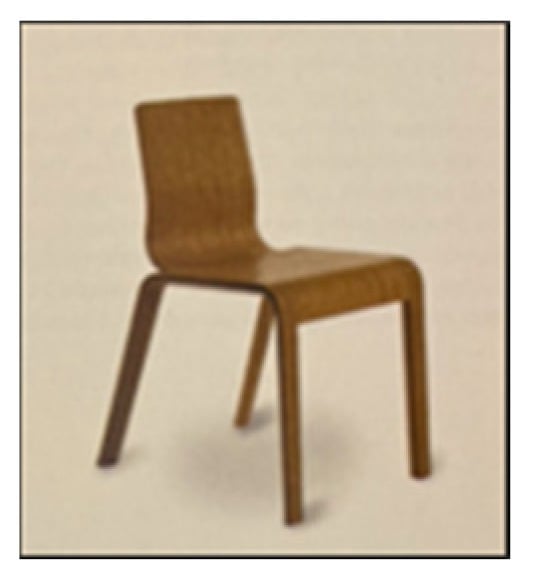
Figure 8.
Chair made of bamboo wood. Bamboo is a natural resource that is fast-growing, easy to regenerate, and lightweight [30].
- Sustainable furniture:
Developing classrooms by providing furniture that provides users with more comfort contributes to maintaining their health. Thus, the sustainable concept in furniture design is important and focuses on increasing the entire life cycle of furniture, starting from the extraction of raw materials through manufacturing, distribution, and use to final disposal, in addition to achieving environmental and healthy goals in a single intellectual system [31]. Sustainable furniture design combines environmental sustainability and health and achieves quality standards and the effective functional performance of furniture for the longest possible period, characterized by durability, flexibility, a long life, and a lack of polluting materials [32]. Therefore, the furniture materials and its finishing and upholstery materials must be environmentally friendly and less harmful to human health and the environment. Moreover, the materials must also contain zero or a low percentage of volatile organic compounds, and the piece of furniture must be easy to disassemble and reassemble, in addition to the possibility of recycling it at the end of its use period and its ability to decompose easily. Finally, furniture should be chosen in a way that conserves energy and reduces the use of natural materials [21,26].
- Lighting quality in interior design:
The visual environment is one of the most important elements that affect the learning process; it affects students’ performance in their attendance and behavior inside the classrooms. It can give a hall a feeling of warmth and welcome or coldness and spaciousness. Good lighting also helps people to enjoy colors, shapes, and dimensions. Diverse lighting enables students to integrate and participate, giving them more comfort and luxury. Therefore, the design standards of the educational environment should be taken into account; its design should include sufficient windows in terms of number and space to rely on natural lighting sources first, using advanced daylighting and shading techniques, and artificial lighting second so that it contributes to providing healthier and more vibrant educational environments [33].
- Constraints to Consider When Applying Sustainable Design Standards to Interior Environments:
These constraints include the following:
- -
- The high cost of sustainable materials:
This increases the budget compared to traditional interior designs. However, this has been overcome through alternative solutions such as the use of local and recycled materials in Saudi Arabia, which are less expensive.
- -
- Selection of Sustainable Materials:
Some sustainable materials may be limited or difficult to obtain, and some materials are not suitable for local climatic conditions, leading to the search for local sustainable materials that are compatible and suitable for these conditions.
- -
- Technical Innovation:
Some technical innovations in the field of sustainability are not available or have not been sufficiently tested in interior applications, such as innovative insulation techniques or eco-friendly lighting techniques. Therefore, it is necessary to keep up with the latest innovations in the field and develop innovative solutions that may contribute to improving the environmental performance of space.
- -
- Raising Awareness:
There is a lack of sufficient awareness about the benefits of sustainable design. Therefore, awareness of the importance and benefits of sustainable interior design must be increased.
- -
- Long-term sustainability of materials:
Some sustainable materials are more susceptible to deterioration over time, making them less sustainable in the long run. Therefore, it is important to choose high-quality, durable, and long-lasting materials.
- -
- Economic impact:
Sustainable design is not suitable for some social groups, as not everyone can afford sustainable resources. However, economical and sustainable solutions can be found that suit all social groups.
The authors reviewed some universities and colleges of design and art, some of which have contributed to the application of sustainable design in art studios as shown in Table 3.

Table 3.
Some universities and colleges of design and art have contributed to the application of sustainable design.
Table 3.
Some universities and colleges of design and art have contributed to the application of sustainable design.
| N | Interior Design Concept | Figure |
|---|---|---|
| Pomona College Faculty: Art Department | - The design features wing-like curves that allow natural ventilation throughout the building, inspired by the mountains that characterize nature in California. - Uses solar panels on the roof and green spaces inside the building to provide an environment linked to nature, to enhance the productive and creative efficiency of the occupants of the interior space. | Figure 9 |
| Emily Carr University: Faculty: Art & Design | - The studios are designed with large glass facades to allow sunlight to enter, providing a physical environment that serves the different artistic disciplines. - The sculpture studios are close to the outdoor work and exhibition environments. - The studios are characterized by their spacious, soundproof, and vibration-resistant spaces while employing sustainable LEED Gold strategies [34]. | Figure 10 |
| University of Manitoba. Faculty: Art lab | - Designed a panoramic view of the drawing studios through longitudinal windows in the drawing studios to allow natural light and reduce energy consumption. - The open design of some spaces is a key feature of many studios. - The building’s versatility allows any space to be converted into multi-use spaces to provide new opportunities for students to install, display artwork, and perform [35]. | Figure 11 |
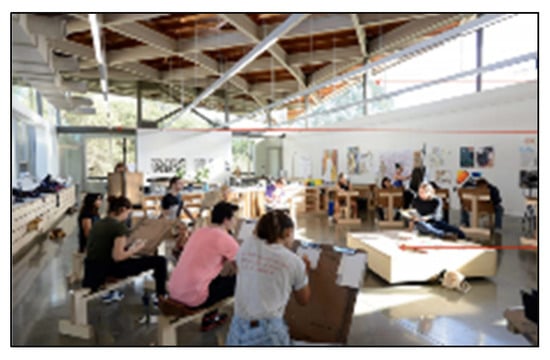
Figure 9.
Interior design of the visual arts studio; https://www.archdaily.com/552408/in-progress-pomona-college-studio-art-hall-why-architecture (accessed on 12 August 2023).
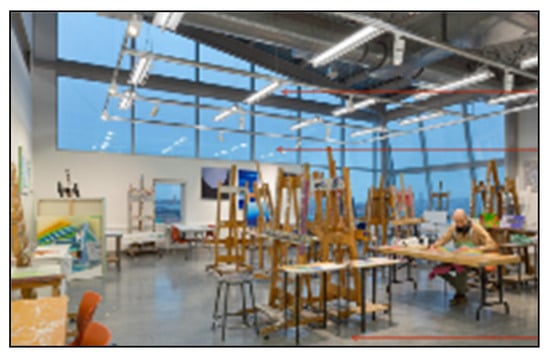
Figure 10.
Interior design and furniture elements of an art studio.
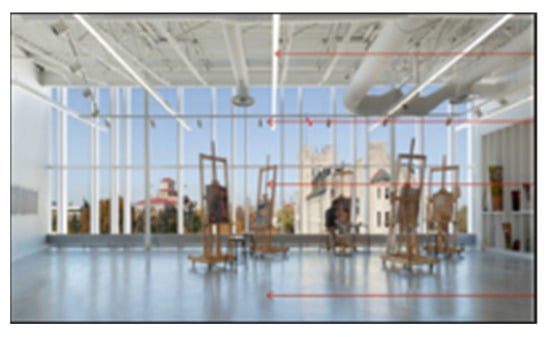
Figure 11.
The panoramic interior design of the art studio emphasizes the connection with the outdoors.
8. Results and Discussion
- -
- Distribution of the study sample of faculty members according to the gender variable:
The characteristics of the study sample of 44 participating faculty members, based on demographic variables are shown in Table 4. The study sample of faculty members included 16 male faculty members, representing 36.4%, and 28 female faculty members, representing 63.6%.

Table 4.
Distribution of study individuals according to the gender variable.
- -
- Distribution of the study sample of students according to the gender variable:
The characteristics of the study sample of students according to demographic variables are shown in Table 5.

Table 5.
Distribution of study individuals according to the specialization variable.
The number of female students was 102, representing 75% of the sample, and the number of males in the study sample was 34, representing 25% of the study sample.
- Answering the study questions
The current study sought to determine the design standards that must be achieved to create environmental sustainability in classrooms, identify the reality of classrooms in light of those standards, and reach a proposed design vision for classrooms through them. To achieve this, the arithmetic averages and standard deviations of the responses of faculty members and students in the Department of Art Education at King Faisal University were used on the two questionnaires prepared for this purpose, and the results of this are presented in detail in Table 6 and Table 7.

Table 6.
Arithmetic means and standard deviations of faculty members’ responses to the questionnaire.

Table 7.
Arithmetic means and standard deviations of students’ responses to the questionnaire.
Table 6 shows the arithmetic means and standard deviations of faculty members’ responses to the questionnaire in general. The results show that faculty members’ responses appeared in a small way on the questionnaire in general and its three axes, with a general average of 2.15 and a standard deviation of 0.747. The field of design standards for classrooms came first with an arithmetic mean of 2.29 and a standard deviation of 0.706, then the psychological and physiological needs axis with an arithmetic mean of 2.16 and a standard deviation of 0.723. The reality of the classroom axis came last with an average of 2 and a standard deviation of 0.815. The degree of agreement for all axes was low. As for the students’ responses to the questionnaire presented to them, see Table 7. It is clear that their responses also appeared in a small way on the questionnaire in general, as the arithmetic mean of the students’ responses was 1.98 with a standard deviation of 0.701. The first place in terms of response was the reality of classrooms axis with an arithmetic mean of 2.11 and a standard deviation of 0.689, followed by the psychological and physiological needs axis with an arithmetic mean of 1.85 and a standard deviation of 0.712. The responses appeared in a small way on the two axes of the questionnaire submitted to the students at King Faisal University. The following discusses the results of the responses of the faculty members and students at King Faisal University in some detail concerning the design standards that must be achieved to create environmental sustainability in classrooms and the reality of classrooms in light of those standards.
Results of answering the first question: The first question stated: “What is the reality of the classrooms in the Art Education Department at King Faisal University in light of the design standards that must be achieved to create environmental sustainability in the classrooms in the Art Education Department?”.
This was discussed through the viewpoints of faculty members and students at the university as follows.
First, the arithmetic averages and standard deviations of the faculty members’ responses to the paragraphs related to the axis of the reality of the classrooms in the Art Education Department at King Faisal University, in light of the design standards, were calculated and are shown in Table 8.

Table 8.
Arithmetic means and standard deviations of faculty members’ responses to the paragraphs related to the suitability of classrooms in the Art Education Department at King Faisal University.
Table 8 shows that the arithmetic averages of the faculty members’ approval scores for the paragraphs related to the suitability of the classrooms in the Art Education Department at King Faisal University ranged between 1.73 and 2.16, where statements 2, 1, 3, and 5 received low approval scores, the highest of which was statement No. 2, which stated, “The furniture used in the classrooms is flexible and easy to move and rearrange”, and received the highest arithmetic average value of 2.16, while statement No. 4, which stated, “The materials used in the flooring of the classrooms in the Art Education Department are suitable for the nature of the department”, and received the lowest arithmetic average value of 1.73 and a very low approval score. The table also shows that the overall arithmetic average over all statements was 2.00 and they obtained a low approval score, which indicated that the classrooms in the Art Education Department at King Faisal University were, from the faculty members’ point of view, slightly suitable. As for students’ responses to the reality of classrooms in the Art Education Department at King Faisal University, in light of design standards, the arithmetic averages and standard deviations of the responses of the students in the study sample were calculated on the statements related to the suitability of classrooms from the student’s point of view, and Table 9 illustrates this.

Table 9.
Arithmetic means and standard deviations of students’ responses to the statements related to the suitability of classrooms in the Art Education Department at King Faisal University.
Table 9 shows that the arithmetic averages of students’ approval scores for the statements related to the suitability of classrooms in the Art Education Department at King Faisal University ranged between 1.32 and 3.24, where statements 9 and 6 received medium approval scores, the highest of which was statement 9, which stated, “There are smart technologies such as smart boards and projectors in classrooms”, as it received the highest arithmetic average of 3.24, while statements 7, 3, and 2 received low approval scores, while the rest of the statements received very low approval scores, the lowest of which was statement 8, which stated, “There is a waste container designated for recycling in the corridors of the classrooms in the Art Education Department”, as it received the lowest arithmetic average of 1.32. The table also shows that the overall arithmetic average over all statements was 2.11 and they obtained a low approval score, indicating that the classrooms in the Art Education Department at King Faisal University were slightly suitable from the students’ point of view.
Results of answering the second question: The second question stated, “What are the design standards that must be achieved to create environmental sustainability in the classrooms of the Art Education Department?”, and was answered by calculating the arithmetic averages and standard deviations of the faculty members’ responses to the statements related to the axis of the design standards that must be achieved to create environmental sustainability in the classrooms of the Art Education Department, as well as the responses on the axis of psychological and physiological needs from the point of view of faculty members and students. This was explained as follows.
Table 10 shows that the arithmetic averages of faculty members’ approval scores for the statements related to the suitability of the design standards required to be achieved to create environmental sustainability in the classrooms of the Art Education Department at King Faisal University ranged between 1.50 and 2.73, where statement No. 8, which stated, “There is a dedicated hall in the Art Education Department to preserve students’ artwork”, obtained the highest arithmetic average of 2.73, while the rest of the statements obtained low approval scores, except for statement No. 9, which stated, “There is a waste container designated for recycling in the corridors of the classrooms in the Art Education Department”, and obtained the lowest arithmetic average of 1.50 and a very low approval score. The table also shows that the overall arithmetic average over all statements of the design standards required to be achieved to create environmental sustainability in the classrooms of the Art Education Department was 2.29 and they obtained a low approval score, which indicated that the design standards required to be achieved to create environmental sustainability in the classrooms of the Art Education Department at King Faisal University from the point of view of faculty members were slightly appropriate.

Table 10.
Arithmetic means and standard deviations of faculty members’ responses to the statements related to the suitability of the design standards required to create environmental sustainability in classrooms.
Results of answering the third question: The third question stated, “What are the psychological and physiological needs that must be available in classrooms?”, and was answered and discussed through the points of view of faculty members and students at the university as follows. The arithmetic means and standard deviations of faculty members’ responses to the statements related to the suitability of psychological and physiological needs were calculated and are shown in Table 11.

Table 11.
Arithmetic means and standard deviations of faculty members’ responses to the statements related to the suitability of psychological and physiological needs.
Table 11 shows that the arithmetic averages of faculty members’ approval scores for the statements related to the suitability of psychological and physiological needs ranged between 1.89 and 2.59, and all of them had low approval scores. For instance, statement No. 3, which stated, “You feel spatial satisfaction while you are inside the classrooms,” obtained the highest arithmetic average value of 2.59, while statement No. 2, which stated, “There is noise inside the classrooms that affects your work performance,” obtained the lowest arithmetic average value of 1.89. The table also shows that the overall arithmetic average over all statements was 2.16, and they obtained a low approval score, which indicated that the psychological and physiological needs from the faculty members’ point of view were slightly appropriate. The arithmetic averages and standard deviations of the students’ responses to the statements related to the suitability of psychological and physiological needs were calculated, and Table 12 illustrates this.

Table 12.
Arithmetic means and standard deviations of students’ responses to the statements related to the suitability of psychological and physiological needs.
Table 12 shows that the arithmetic averages of students’ approval scores for the statements related to the suitability of psychological and physiological needs ranged between 1.45 and 2.43. All of them had low approval scores, with statements 5, 3, 4, 6, and 7 receiving low approval scores, the highest of which was for statement 5, which stated, “The colors used help to feel active and willing to learn”, as it received the highest arithmetic average value of 2.43. In contrast, the rest of the statements received very low approval scores, the lowest of which was statement 8, which stated, “There are safety signs in the classrooms,” as it received the lowest arithmetic average value of 1.45. The table also shows that the overall arithmetic average over all statements was 1.85, and they obtained a low approval score, which indicated that the psychological and physiological needs from the students’ point of view were suitable to a small degree.
Results of answering the fourth question: The fourth question was answered, which stated: “What is the proposed vision for designing the classrooms in the Art Education Department through the design standards necessary to achieve environmental sustainability in them?”.
- -
- The proposed concept for the design of classrooms, through these design standards, is to achieve environmental sustainability in the classrooms of the Art Education Department:
A proposed concept for classrooms was presented in light of the sustainable design standards that this study reached after analyzing the responses of faculty members and students to the electronic questionnaire and identifying their opinions and suggestions. They were considered in the proposed design and applied to the ceramics classroom, the plastic arts classroom, and the graphic design and multimedia classroom in the Art Education Department through the use of the commonly known three-dimensional interior design programs.
- 1-Ceramic Art and Techniques Teaching Classroom (King Faisal University).
- -
- Floor plan of the ceramic art and techniques classroom:
The floor plan of the classroom for teaching ceramic art and techniques was re-planned by studying the floor plan and designing it according to the educational, functional, and aesthetic needs and requirements that were compatible with teaching the course. Providing flexible, effective, and dynamic workspaces, the floor plan of the classroom helped provide flexible movement paths that contributed to encouraging students to work in groups by providing shared workspaces where they exchanged creative ideas, enjoyed artistic work, and felt more freedom to produce ceramic artworks as in the floor plan Figure 12.
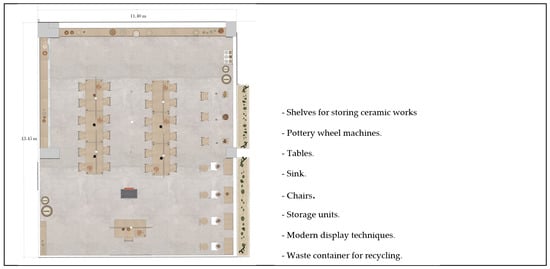
Figure 12.
The floor plan of the ceramic art and techniques classroom. [Source: The authors].
- -
- Space analysis:
The proposed interior design of the classroom for teaching ceramic art and its techniques is shown in Figure 13. It provides spaces suitable for the nature of the course, shared workspaces that encourage teamwork, equipped with different furniture elements, units according to functional requirements designated for storing artworks, furniture units designated for shaping and sculpting ceramics, a teaching office designated for faculty members, and the distribution of industrial lighting units directed towards the work area precisely to make clearer and reduce brightness to achieve the internal visual comfort of the hall. Sustainable materials were chosen for finishing the walls, floors, and paint according to the best proposals of some scientific studies.
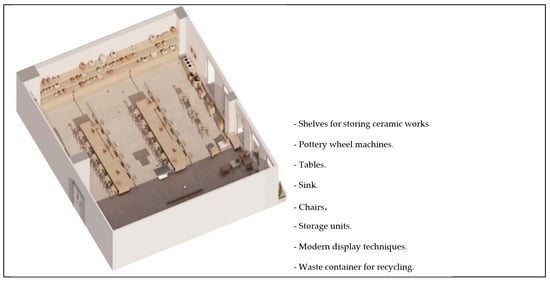
Figure 13.
The general view of the ceramic art and techniques classroom. [Source: The authors].
- -
- Movement analysis:
The internal movement paths were considered in the floor plan design of the ceramics hall, focusing on the flexibility of students’ movement and various functions within the classroom, so that the design provided them with a smooth flow, as the movement areas were integrated with the functional spaces and various work surfaces that met their functional and educational needs.
- -
- The interior design concept of the ceramics classroom and its techniques:
The proposed interior design of the ceramics classroom was based on inspiration from the local natural environment through the use of sustainable environmental materials and reliance in the interior design treatments and furniture elements on the colors of sand from the natural desert that characterizes nature in the Kingdom of Saudi Arabia, which achieved harmony between the external desert and its integration with the internal environment of the ceramics hall as in Figure 14. In addition to employing outdoor plants in the interior space, it achieved a high level of indoor environmental quality in learning spaces. In addition, the design made the most of the natural light entering the space to create a feeling of openness and natural flow, by widening the glass openings to reduce the use of artificial light, as shown in Figure 15.

Figure 14.
Interior layout, the distribution of different furniture elements, and the design of movement paths. [Source: The authors].

Figure 15.
Interior design and treatment of the windows in a way that helps students be in direct contact with the outside nature. [Source: The authors].
- -
- Interior furniture elements:
Different furniture units were selected to suit the functional requirements of teaching the ceramics course. They were characterized by a simple design, flexibility, and ease of movement according to their functional purpose. Closed storage units were placed to keep clay, ceramic tools, and their materials, and to keep some artistic pieces, and shelves were placed to display artworks. A part of the classroom was allocated to sculpture furniture elements, pottery wheel machines, and a special sink for the classroom, as shown in Figure 16. The hall was also equipped with modern technologies such as hologram technology, which helps display artwork in 3D to add positive interaction for students during the educational process without feeling bored, as shown in Figure 17.
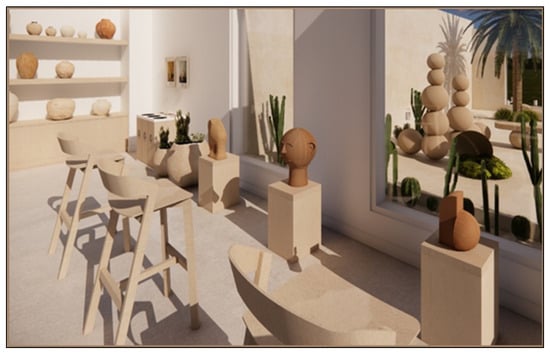
Figure 16.
Elements of sculpture furniture and pottery wheel machinery. [Source: The authors].

Figure 17.
Use of hologram artwork display technology in the educational process. [Source: The authors].
- 2-Plastic Art Teaching Classroom (King Faisal University).
- -
- Floor plan of plastic art teaching classroom:
The floor plan of the plastic art teaching classroom was re-planned by studying the floor plan and designing it according to the educational, functional, and aesthetic needs and requirements that were compatible with teaching the course with its various applications. Providing flexible, effective, and dynamic workspaces, the floor plan of the classroom helped provide flexible movement paths that allowed for smooth movement and contributed to encouraging students to work in groups by providing shared workspaces where they exchanged creative ideas, enjoyed artistic work, and felt more freedom to produce artistic works as in the floor plan in Figure 18.
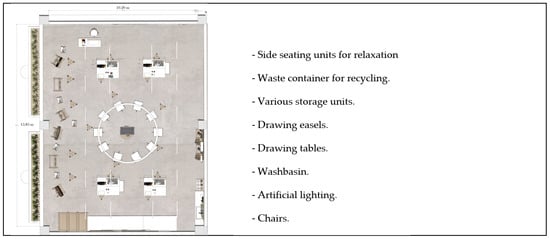
Figure 18.
The floor plan of the plastic art classroom designed in this study. [Source: The authors].
- -
- Space analysis:
The proposed interior design of the classroom for teaching plastic art at the College of Education at King Faisal University is shown in Figure 19. It includes spaces suitable for the nature of the course, shared workspaces that encourage cooperation and teamwork, spaces equipped with different furniture elements according to functional requirements designated for storing artwork, furniture units designated for drawing, and a teaching desk designated for faculty members. In addition, the design distributed industrial lighting units spread around the workspaces to accurately show details, to display clearer colors, and to reduce brightness to achieve harmony between students and the environment. Sustainable wall and floor finishes and paints were chosen.
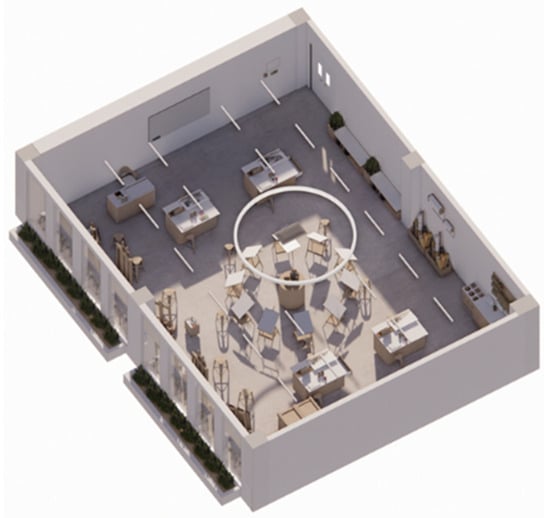
Figure 19.
General perspective of the plastic art classroom. [Source: The authors].
- -
- Movement analysis:
The internal movement paths were considered in the floor plan design of the plastic art classroom, focusing on the movement of students and the various functions within the classroom. Thus, the design provided them with a smooth flow, as the movement areas were integrated with the functional spaces and various work surfaces that met their functional and educational needs. The floor plan was divided to include an individual workspace and a group workspace that suited different learning styles.
- -
- The interior design concept of the plastic art classroom:
The proposed interior design concept of the plastic art classroom was based on inspiration from the local natural environment through the use of sustainable environmental materials and reliance in the interior design treatments and furniture elements on the colors of sand from the natural desert that characterizes nature in the Kingdom of Saudi Arabia. This achieved harmony between the desert and the heritage architectural character of the Al-Ahsa region and highlighted the furniture pieces and their simple design, as shown in Figure 20. Maximum benefit from the entry of natural lighting was used to create openness and natural flow through the expansion of glass openings and to reduce the use of artificial light. Different furniture units were chosen to suit the functional requirements of teaching the course, characterized by their flexibility and ease of movement according to the functional purpose. The drawing stands were arranged in a circular shape that allowed for a sense of participation and teamwork while drawing, as shown in Figure 20.
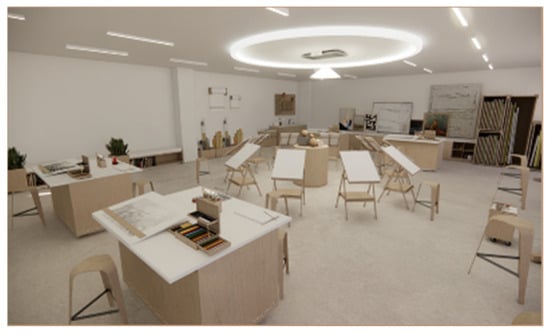
Figure 20.
The perspective shows the interior design of the plastic art classroom and the distribution of furniture elements. [Source: The authors].
The classroom was provided with storage units that allowed for the preservation of colors and plastic art tools, and the preservation of paintings printed on canvas, with cabinets to preserve artwork printed on drawing papers, as shown in Figure 21.
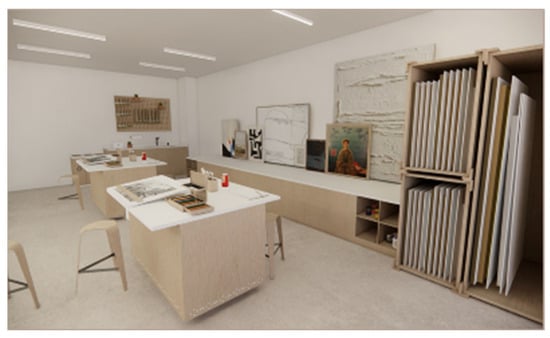
Figure 21.
The interior design of the classroom shows the distribution of the different furniture elements (worktables and vertical and horizontal art storage units). [Source: The authors].
- 3-Graphic Design and Multimedia Classroom (King Faisal University).
- -
- Floor plan of the graphic design and multimedia classroom:
It was re-planned according to educational, functional, and aesthetic needs and requirements by providing flexible movement paths that contributed to encouraging students to work in groups and individually in addition to providing shared workspaces that suited different learning styles, where they exchanged creative design ideas, as shown in Figure 22.
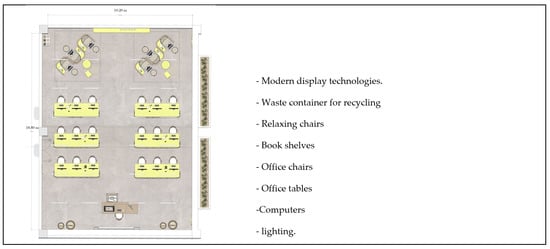
Figure 22.
Floor plan of a graphic design and multimedia classroom. [Source: The authors].
- -
- Space analysis:
The proposed interior design of the classroom provides functional interior spaces that are appropriate to the nature of the course, and shared workspaces that encourage group and individual work, equipped with furniture units dedicated to the functional requirements of computer halls. It considered the distribution of industrial lighting units according to the workspaces to accurately show details while reducing brightness to achieve harmony between students and the quality of the internal environment of the classroom, in addition to choosing sustainable materials for finishing walls, floors, and paints according to the best proposals for some scientific studies, as seen in Figure 23.
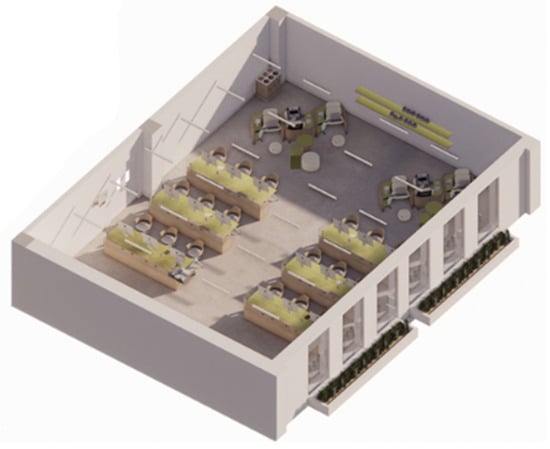
Figure 23.
General perspective of a graphic design and multimedia classroom. [Source: The authors].
- -
- Movement analysis:
The internal movement paths were designed in the floor plan design of the classroom and considered the movement of students and the various functions within the classroom so that the design of the movement paths provided students with a smooth flow, ensuring the efficient use of the functional spaces, and various work surfaces that met their educational needs.
- -
- The interior design idea of the graphic design and multimedia classroom:
The interior design of the classroom was based on inspiration from the local natural environment through the use of sustainable environmental materials and reliance in the interior design treatments and furniture elements on the colors of sand, sky, and trees, which achieved harmony with nature by integrating it with the internal environment and making the most of natural lighting to create openness and natural flow by modifying the dimensions of the glass windows.
- -
- Interior furniture elements:
The different furniture units were selected to suit the functional requirements of teaching the course. Their design was characterized by simplicity and flexibility, as in Figure 24. They were equipped with computers and office chairs, with shelves colored in natural colors, especially for placing books. A part of the classroom was allocated to contain six seating units (relaxation chairs) equipped with laptop computers, as shown in Figure 25.
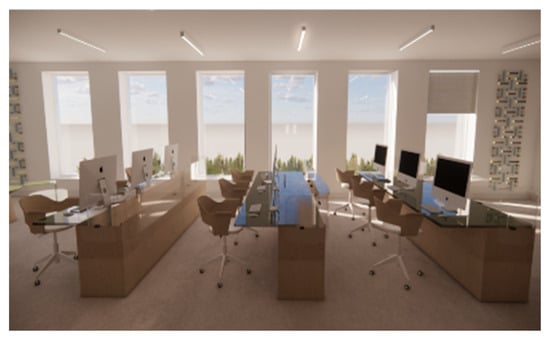
Figure 24.
Interior design of the classroom with the distribution of different furniture elements and the design of the windows. [Source: The authors].

Figure 25.
Interior design of the hall showing the distribution of furniture elements (worktables equipped with computers; chairs; relaxation). [Source: The authors].
- Indoor environmental quality in classrooms:
- -
- Natural light.
The climate of the Kingdom of Saudi Arabia is characterized by being very hot and semi-arid in general, so it poses a challenge in designing classrooms lit by natural light to reduce energy consumption. As a result, this study suggests improving the designs of windows in the hall and integrating light shelves. One study showed that the best solution for enhancing the balance between increasing daylight and reducing heat was to apply a multi objective improvement strategy that increased useful daylight in a range from 43.58% to 58.37% and reduced glare by 95% to 100%, which led to an improvement in energy use intensity by 1.81% to 3.88%, as shown in Figure 26, and distributing daylight more evenly and efficiently [36].

Figure 26.
Multi-objective optimization strategy [36].
We also suggest to equip classrooms with energy-saving glazing systems that are compatible with the nature of the climate in the Kingdom of Saudi Arabia. Some studies have concluded that smart, energy-saving windows with passive radiant cooling can be designed to manage heat throughout the year compared to regular glass [37].
- -
- Artificial lighting.
The importance of artificial lighting in classrooms is highlighted, as it helps students learn better by accurately displaying details and colors so that artwork becomes clearer while reducing brightness and glare. Therefore, artificial lighting was distributed in the ceilings of classrooms using a variety of different lighting sources according to the educational, functional, and aesthetic needs and requirements that were compatible with teaching courses, such as using panel lighting (LED) to obtain diffused lighting, direct lighting to highlight some work areas, and indirect lighting to create a suitable and calm atmosphere in some classrooms.
- -
- Energy efficiency (renewable energy):
The strong sunlight in the Kingdom of Saudi Arabia has contributed to investment in solar energy and made it a major source of renewable energy. Therefore, this study proposes providing a new innovative local cooling system developed by a group of researchers, which is a device that cools solar cells using gravity instead of electricity by extracting water from the air. The device is characterized by being an inexpensive and easy-to-provide material and the possibility of reusing the water produced by the device in irrigation and washing [38]. Based on the above, we propose providing electric lighting based on LEED systems, such as using developed tandem solar cells inside the classroom, as a group of researchers developed tandem solar cells that combined silicon and perovskite cells. The results of this local innovation showed that combining these two materials increased the absorption of sunlight and converted it into electrical voltage more efficiently than traditional solar cells. This innovation was classified as the best solar cell efficiency research by the National Renewable Energy Laboratory (NREL) in the United States of America and was approved by the European Solar Energy Testing Institute [39].
- -
- Wall and floor finishes in classrooms:
The results of one study showed the importance of applying environmentally friendly materials in treating floors, walls, and furniture, to help improve the quality of the indoor environment by reducing indoor air pollutants [40]. Therefore, we suggest using paints made from sustainable materials in classroom walls, such as “novel” paint, invented by Al-Jazeera Paints, a local paint made from sustainable, renewable materials. It is characterized by being healthy, odorless, free of harmful chemicals and volatile organic materials, and has excellent resistance to microbes such as fungi, bacteria, stains, and dirt, with easy cleaning and applying to walls without using chemicals [41]. The wood used in classroom furniture should also be preserved by using coatings that are compatible with the nature of the wood material and preserve it, such as nanoparticle composite coating, which is characterized by being super-hydrophobic and free of fluorine, as shown by a previous study, and it is a suitable coating for interior and exterior applications of wood and maintains the durability of surfaces with its ability to self-clean over the long term [42]. We also suggest using a sustainable cement floor in classrooms as a cement material developed from local volcanic ash was characterized by its durability, low cost, fire resistance, friction resistance, and a reduced environmental impact, such as greenhouse gases [43].
- -
- Sound insulation (acoustic comfort):
Achieving acoustic comfort inside classrooms is one of the important factors that help improve the quality of the indoor environment and enhance psychological and physical comfort to enable students to easily bring their creative ideas. To enhance acoustic quality, we suggest integrating fabric panels into walls made of sustainable local date palm fiber fabric, as sound-absorbing panels in interior spaces that help provide calm and well-being for users of the interior space. One study concluded that these fabric panels were a more energy-efficient alternative to synthetic insulating materials and could be easily reused or recycled directly for various other purposes [29].
- Apparent validity of the proposed concept:
To verify the validity of the proposed concept, it was presented to fourteen arbitrators specialized in the fields of design and arts, interior design, environmental engineering, and architecture. They were given a form to evaluate the proposed concept as shown in Appendix A, and the agreement coefficient for the arbitrators’ opinions about the proposed concept was calculated according to the following equation: Agreement coefficient = (number of times of agreement/number of times of agreement + number of times of disagreement). It is clear from Table 13 that the agreement coefficient about the proposed concept was high, as its value reached 0.95, which indicated the existence of a high apparent validity for the proposed concept and a great agreement among the arbitrators about it.

Table 13.
Coefficient of agreement as an indicator of face validity.
The apparent validity of the proposed concept was also verified through the chi-square (Chi2) test. Its significance was adopted as a criterion for accepting the judgment on the content validity of the proposed concept. It is clear from Table 14 that the value of the chi-square (Chi2) statistic was significant, and based on that, the proposed concept was accepted according to the opinions of the arbitrators and their agreement on its components and contents as shown in Table 15.

Table 14.
Apparent validity of the arbitrators using chi-square (Chi2) test.
The authors presented a design proposal based on sustainable design for the three classrooms in the Department of Art Education at King Faisal University, and its validity was verified by the arbitrators in the field of design, arts, interior design, environmental engineering, and architecture, and it was agreed upon with a high acceptance rate.

Table 15.
A comparison between the current interior design of the classrooms in the Department of Art Education, King Faisal University, and our design proposed.
Table 15.
A comparison between the current interior design of the classrooms in the Department of Art Education, King Faisal University, and our design proposed.
| Current Interior Design and Proposed Design | Comparative Aspects | |
|---|---|---|
| 1 | Ceramic Art and Techniques Teaching Classroom | |
| Figure 27 | 1-Furniture materials: The furniture materials were environmentally friendly, using local palm frond waste wood material for the furniture elements. In addition, it was functionally and design-wise compatible with the course of ceramics and its teaching requirements. 2-Flooring material: A cementitious material developed from local volcanic ash was used in the flooring, which is durable, low-cost, resistant to friction, and fire resistant, and reduces environmental impact, such as greenhouse gases. 3-The interior design of the classroom was functionally compatible with the requirements of the educational environment. | |
| 2 | Plastic Art Teaching Classroom | |
| Figure 28 | 1-The interior design and furniture elements were inspired by the natural desert sand colors of Saudi Arabia. 2-Maximum benefits from the entry of natural light to create a feeling of openness and natural flow, by widening the glass openings to reduce the use of artificial light. | |
| 3 | Graphic Design and Multimedia Classroom | |
| Figure 29 | 1-The design was based on inspiration from the local natural environment. 2-Used sustainable environmental materials such as local palm frond waste wood. 3-Energy-efficient smart windows managed heat year-round compared to normal glass and low-E commercial glass. Enabled passive radiant cooling and regulated heating. 4-The color scheme was inspired by the colors of sand, sky, and nature. | |
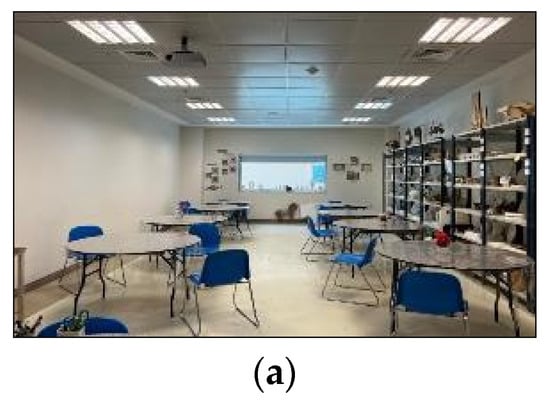
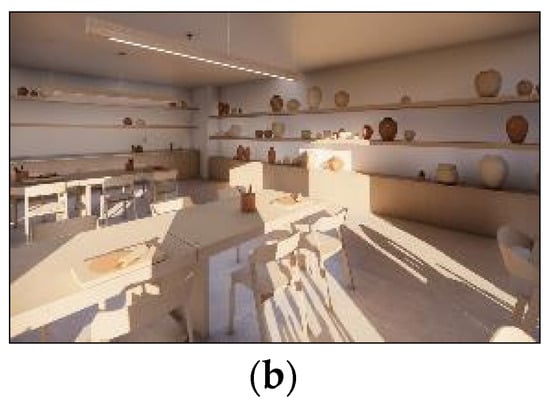
Figure 27.
(a,b) Current interior design and proposed interior design. [Source: The authors].
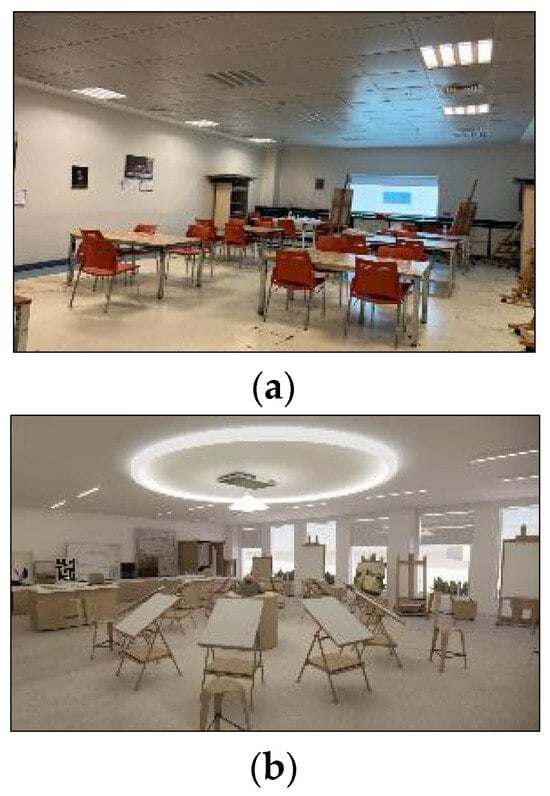
Figure 28.
(a,b) Current interior design and the proposed interior design. [Source: The authors].

Figure 29.
(a,b) Current interior design and the proposed interior design. [Source: The authors].
The proposed changes to the sustainable interior design of the classrooms are able to improve environmental efficiency and student outcomes through our commitment to the following:
- -
- Choosing materials with environmental origins, such as the wood from local palm frond waste that was used in the furniture elements.
- -
- Choosing a cement material developed from local volcanic ash that was used in the floors, characterized by it durability and low cost, with its resistance to fire and friction, and reducing the environmental impact, such as greenhouse gases.
- -
- Using natural lighting effectively, renewable energy sources such as solar energy, by modifying the dimensions of the glass windows in the halls so that they allow light to enter better than before.
- -
- Indoor air quality in classrooms through the use of high-quality tools and the adoption of effective systems to improve indoor air quality.
- -
- Improving the quality of the indoor environment and enhancing psychological and physical comfort by achieving acoustic comfort as one of the important factors that help students to evoke their creative ideas by integrating fabric panels into walls made of sustainable date palm fiber fabric.
- -
- Reducing waste through recycling, as suggested by the presence of recycling containers in the halls.
- -
- Flexible interior design that allows the possibility of designing the interior spaces of classrooms with the highest efficiency and maximum benefit.
- -
- Use smart technology in the teaching process by providing hologram display devices.
- -
- Improving indoor air quality by using high-quality materials such as paints and coatings and improving the air quality system within the interior spaces of classrooms.
- Study contribution
This study of sustainable interior design for classrooms for art and design students at King Faisal University contributes to providing practical, psychological, environmental, and educational insights through the following:
- -
- Achieving the objectives of Saudi Vision 2030 in education and sustainability.
- -
- This study highlighted a local university experience that can be developed and emulated.
- -
- This study promoted sustainable design practices in Arab educational environments.
- -
- Sustainable interior design for classrooms helps reduce environmental impact through sustainable materials, efficient lighting, and improved ventilation, which helps reduce carbon footprints and waste production.
- -
- It encouraged renewable resources such as recycled wood and wood manufactured from palm waste. Due to their abundance, these woods are durable and inexpensive. Over 34 million palm trees are distributed throughout the Kingdom, and they are easy to maintain and highly resistant to corrosion and weather conditions, particularly the extreme heat of Saudi Arabia’s climate.
- -
- It improved students’ mental health and cognitive abilities by integrating natural elements into interior design by focusing on natural lighting and good natural ventilation. This impacts on student concentration and reduces their levels of stress and anxiety.
- -
- Sustainable interior design for educational environments provides flexible designs that adapt to different teaching strategies, such as cooperative and individual learning, to suit different curricula, enabling students to participate positively and effectively in learning environments.
- -
- The sustainable classroom design in this study is an educational tool that instills the concepts of sustainability, environmental stewardship, and responsibility. It also helps students integrate sustainability into design projects.
- -
- This study presented a case study model that contributes to future educational research in sustainable interior design for educational environments.
- Integrating Sustainable Design Principles at King Faisal University:
Sustainability has become a key focus in the design of contemporary educational environments, contributing to improving the quality of education, enhancing students’ mental and physical health, and reducing the environmental impact of educational institutions. In line with the national drive to achieve sustainable development goals, Saudi universities, including King Faisal University, are adopting sustainable design principles within their infrastructure and educational facilities. This supports the national drive towards sustainability (Saudi Vision 2030). Furthermore, implementing sustainable design at the university contributes to reducing long-term operational costs, improving the quality of life for students and faculty, and highlighting the university’s role as a cultural landmark in the Eastern Province.
- -
- Sustainable design is integrated into King Faisal University’s buildings and infrastructure through the use of environmentally friendly building materials.
- -
- Solar energy is used for lighting and air conditioning.
- -
- Energy-efficient LED lighting systems are used in all facilities.
- -
- Thermal insulation systems are implemented to reduce energy consumption.
- -
- Smart building designs are incorporated through light sensing, temperature control, and natural ventilation.
- -
- Landscape and environment, such as planting local plants that consume little water (suitable for the arid climate of Al-Ahsa).
- -
- Preserving green spaces as recreational and educational areas.
- -
- Recycling waste through waste segregation on campus.
- -
- Integrating sustainability and environmental design into the curriculum.
- -
- Supporting sustainability research in collaboration with the engineering, agricultural, and environmental colleges.
The proposed design for the classrooms in the current study represents a supportive and confirmatory example of King Faisal University’s orientations and Saudi Arabia’s Vision 2030.
9. Conclusions and Suggestions
This design proposal contributed to meeting the requirements of the Art Education Department by creating a healthy and organized learning environment. The interior design of the classrooms was designed to fit the requirements of the Art Education Department’s courses and was equipped with appropriate furniture elements in terms of design, materials, and quantity, commensurate with the student population, fostering creativity and innovation.
The sustainable interior design proposal for the Art Education Department’s classrooms aimed to improve the quality of the indoor environment by achieving sustainable interior design aspects, including the selection of sustainable materials, energy efficiency based on the use of natural lighting and energy-saving LED lighting, and water efficiency. This also included improving indoor air quality and incorporating indoor plant elements into built environments to purify the air, focusing on health and psychological comfort. Furthermore, modern display technologies enhanced student interaction and participation.
The design’s effectiveness was validated by experts in art education, interior design, environmental engineering, and architecture. Their evaluations confirmed the proposal’s alignment with sustainable design principles and its appropriateness for the intended educational setting, resulting in a high acceptance rate. These findings support the conclusion that sustainable interior design can meaningfully enhance educational environments when tailored to departmental and pedagogical needs.
This study presents several suggestions on its topic, as follows:
- -
- Raising awareness of the importance of developing classrooms using sustainable interior design elements compatible with the nature of the Kingdom of Saudi Arabia in its various universities as an introduction to an enriching educational environment for design and art students.
- -
- Focusing on healthy interior design in private classrooms for design and art students, which is based on applying indoor environmental quality standards, by providing fresh air and natural and artificial lighting.
- -
- Focusing on Biophilic Design, by integrating elements of nature with the interior environments of classrooms to achieve harmony between the environment and the users of the interior space.
- -
- Conducting more studies on sustainable design as a major trend in interior design to raise environmental awareness, its importance in education, and its role in designing classrooms and design and art studios at universities.
- -
- Conducting a study that reveals the obstacles to applying sustainable interior design in practical and theoretical classrooms at universities.
- -
- Conducting studies on the latest sustainable materials that can be used in classrooms.
- -
- Conducting a study on the importance of using local sustainable materials in classrooms to increase local investment and raise the Kingdom’s economy.
- -
- Promoting and disseminating this study to the rest of the university’s facilities.
- -
- The possibility and support for its application in other Saudi and Gulf universities.
Author Contributions
Conceptualization, M.A. and A.S.A.; methodology, M.A.; validation, M.A. and A.S.A.; formal analysis, M.A. and A.S.A.; investigation, M.A.; resources, M.A. and A.S.A.; data curation, M.A.; writing—original draft preparation, M.A.; writing—review and editing, A.S.A.; visualization, M.A.; supervision, A.S.A.; project administration, M.A. and A.S.A. All authors have read and agreed to the published version of the manuscript.
Funding
This research was funded by the Deanship of Scientific Research, Vice Presidency for Graduate Studies and Scientific Research, King Faisal University, Saudi Arabia [Grant No. KFU251386].
Institutional Review Board Statement
This study was conducted in accordance with the Declaration of Helsinki and approved by the Ethics Committee of King Faisal University (protocol code: KFU-REC_2022_SEP-ETHICS69 and date of approval: 13 September 2022).
Informed Consent Statement
Informed consent was obtained from all individual participants included in this study.
Data Availability Statement
The data supporting this study’s findings and conclusions are available upon request from the corresponding author.
Conflicts of Interest
The authors declare no conflicts of interest.
Appendix A
Evaluation form for a sustainable interior design proposal for classrooms in the Department of Art Education at King Faisal University.
The evaluation form includes a set of design criteria adopted by the authors in the design proposal. These criteria consist of seven basic criteria: furniture, lighting, windows, finishes, flooring, sources of materials used, and interior design of the classrooms. Each criterion includes a set of statements, so the form consists of 26 statements, as shown in Table A1.

Table A1.
Evaluation form for a sustainable interior design proposal for classrooms in the Department of Art Education.
Table A1.
Evaluation form for a sustainable interior design proposal for classrooms in the Department of Art Education.
| N | The Specific Design Aspects to Evaluate | Verified | Partially Verified | Not Verified |
|---|---|---|---|---|
| Furniture: | ||||
| 1 | The furniture used in classrooms is functionally and design-wise compatible with the diversity of study areas in the Department of Art Education. | |||
| 2 | The materials used in the furniture are environmentally friendly. | |||
| 3 | The furniture used is flexible and easy to move and rearrange. | |||
| 4 | The materials used in the furniture are easy to clean. | |||
| Lighting: | ||||
| 5 | Highly efficient natural lighting was achieved in the classrooms. | |||
| 6 | Effective artificial light distribution was achieved. | |||
| 7 | Choose energy-efficient artificial lighting. | |||
| 8 | Employing artificial lighting that has a positive physiological and psychological effect. | |||
| Windows: | ||||
| 9 | The glass used in window design is made of environmentally friendly materials. | |||
| 10 | The glass used in window design is suitable for the nature of the extremely hot climate. | |||
| 11 | The dimensions of classroom windows allow for sufficient natural lighting inside the halls. | |||
| 12 | The window design facilitates direct contact with the outdoors, which enhances students’ productivity and comfort. | |||
| Wall finishes: | ||||
| 13 | Wall paint colors inside classrooms achieve a feeling of psychological comfort. | |||
| 14 | The colors of the furniture elements inside the classrooms match the nature of the study in the Art Education Department. | |||
| 15 | Interior wall paints in classrooms are made of environmentally friendly materials. | |||
| Flooring | ||||
| 16 | The flooring materials inside the classrooms are made of environmentally friendly materials | |||
| 17 | The flooring materials used inside the classrooms are compatible with the nature of study in the Art Education Department. | |||
| 18 | The colors of the flooring materials used inside classrooms achieve the functional aspect. | |||
| 19 | Plants used in classrooms contribute to indoor environmental quality. | |||
| Sources of materials used in classrooms. | ||||
| 20 | Sources of furniture materials used in classrooms. | |||
| 21 | Sources of flooring materials inside classrooms. | |||
| 22 | Sources of classroom wall paint materials. | |||
| Classroom interior design | ||||
| 23 | Achieving sustainable design considerations in the interior design of classrooms in the Art Education Department. | |||
| 24 | Classroom interior design achieves a sense of design comfort. | |||
| 25 | The interior design of classrooms contributes to students’ creativity and innovation. | |||
| 26 | The interior space of the classrooms is both functionally and design-wise consistent with the requirements of the educational environment in the Art Education Department. |
References
- Husain, T.; Khalil, A.A. Environment and sustainable development in the Kingdom of Saudi Arabia: Current status and future strategy. J. Sustain. Dev. 2013, 6, 14. [Google Scholar] [CrossRef]
- Al-Sarf, M. Sustainable Housing in the Kingdom of Saudi Arabia: Opportunities and Challenges, 1st ed.; Universal Co. Publisher & Distributor: Beirut, Lebanon, 2019. [Google Scholar]
- Sweidan, A.H.A.A. Indoor Environmental Quality in Sustainable Interior Design and the Impact of Advertising as a Determinant in Developing Cultural Awareness. In Proceedings of the Eighteenth Conference at Philadelphia International University, Amman, Jordan, 26–28 August 2013. [Google Scholar]
- Attmann, O. Green Architecture: Advanced Technologies and Materials; McGraw-Hill Education: Berkshire, UK, 2010. [Google Scholar]
- Al-Houthi. The role of sustainable environmental architecture in the interior design of tourist resorts. J. Archit. Arts Humanit. 2018, 3, 35–47. [Google Scholar]
- Loftness, V.; Hakkinen, B.; Adan, O.; Nevalainen, A. Elements that contribute to healthy building design. Environ. Health Perspect. 2007, 115, 965–970. [Google Scholar] [CrossRef]
- Spiegel, R.; Meadows, D. Green Building Materials: A Guide to Product Selection and Specification; John Wiley & Sons.: Hoboken, NJ, USA, 2010. [Google Scholar]
- King Faisal University. Sustainable Development Report. 2021. Available online: https://www.kfu.edu.sa/ar/Sustainability/Pages/Sustainability-Report.aspx (accessed on 15 December 2024).
- Terblanche, R.; Khumalo, D. The impact of biophilic design in university study areas on students’ productivity. Archnet-IJAR Int. J. Archit. Res. 2024, 19, 230–247. [Google Scholar] [CrossRef]
- Shams, A.A.M.; Ibrahim, A.H.; Ibrahim, N.M.R.E. The Sustainable interior design for design halls in art faculties to face climate change in the twenty-first century. J. Herit. Des. 2023, 3, 134–160. [Google Scholar] [CrossRef]
- Ramadan, S.E.E.A.R. Necessary considerations for drawing halls in Interior design. J. Archit. Arts Humanit. 2022, 7, 293–306. [Google Scholar] [CrossRef]
- Shaqour, E.N. Improving the architecture design studio internal environment at NUB. J. Adv. Eng. Trends 2021, 41, 31–39. [Google Scholar] [CrossRef]
- Al Najadi, A.; Mohamed, D.; Abdel Karem, E. The concept of sustainable design and its impact on the quality of the internal environment of interior design. J. Archit. Arts Humanit. 2019, 4, 185–200. [Google Scholar] [CrossRef]
- Al-Issawi, O.A.-H. Evaluation of the Educational Environment in Classrooms in University Buildings, the Jerusalem Building at the Islamic University of Gaza as a Case Study. 2020. Available online: https://www.researchgate.net/publication/347527737_qyym_albyyt_altlymyt_fy_alqaat_aldrasyt_fy_almbany_aljamyt_mbny_alqds_fy_aljamt_alaslamyt_bghzt_khalt_drasyt_httpdspaceupedupsxmluihandle123456789402 (accessed on 8 May 2025).
- Abdel Rahman, S.H.; Mohamed, D.A.R.; Abdel Aziz, S.Y. Sustainable interior design and its impact on school buildings. J. Archit. Arts Humanit. 2018, 3, 242–252. [Google Scholar]
- Ahmed, A.M.A.-F. The Role of Interior Design in Improving Design Protocols. Master’s Thesis, University of Sudan, Khartoum, Sudan, 2014. [Google Scholar]
- Lee, M.C.; Mui, K.W.; Wong, L.T.; Chan, W.Y.; Lee, E.W.M.; Cheung, C.T. Student learning performance and indoor environmental quality (IEQ) in air-conditioned university teaching rooms. Build. Environ. 2012, 49, 238–244. [Google Scholar] [CrossRef]
- Ministry of Education. Sustainable Development. 2022. Available online: https://moe.gov.sa/ar/aboutus/aboutministry/Pages/sustainabledevelopment.aspx (accessed on 1 January 2025).
- Azzazy, S.; Ghaffarianhoseini, A.; GhaffarianHoseini, A.; Naismith, N.; Doborjeh, Z. A critical review on the impact of built environment on users’ measured brain activity. Archit. Sci. Rev. 2021, 64, 319–335. [Google Scholar] [CrossRef]
- Chowdhury, S.; Noguchi, M.; Doloi, H. Defining domestic environmental experience for occupants’ mental health and wellbeing. Designs 2020, 4, 26. [Google Scholar] [CrossRef]
- Al-Assaf, S. Introduction to Research in Behavioral Sciences, 5th ed.; Al-Obeikan Libraries and Publishing: Riyadh, Saudi Arabia, 2006. [Google Scholar]
- Anderson, B.G. Transforming the interior design profession for leadership in an ecologically-benign future. In Proceedings of the Interior Design Educators Council 2010 Annual Conference, Atlanta, GA, USA, 1–9 September 2023. [Google Scholar]
- Winchip, S.M. Sustainable Design for Interior Environments, 2nd ed.; A&C Black: London, UK, 2011. [Google Scholar]
- Qanbar, O.A.N.; Labda, A.A.A. Interior design criteria in light of the Green Pyramid Evaluation System. J. Eng. Res. 2019, 3, 48–60. [Google Scholar]
- McLennan, J.F. The Philosophy of Sustainable Design: The Future of Architecture; Ecotone: Kansas City, MO, USA, 2004. [Google Scholar]
- Al Shams, M.A.S. Sustainability in Residential Architecture at the Interior Design Level. J. Coll. Arts Media 2021, 6, 9–43. [Google Scholar]
- Ahn, Y.H.; Choi, Y.O.; Koh, B.W.; Pearce, A.R. Designing sustainable learning environments: Lowering energy consumption in a K-12 facility. Coll. Publ. 2011, 6, 112–137. [Google Scholar] [CrossRef]
- Peters, S. Material Revolution 2: New Sustainable and Multi-Purpose Materials for Design and Architecture; Walter de Gruyter: Berlin, Germany, 2014. [Google Scholar]
- Darwish, E.A.; Midani, M. The potential of date palm midribs-based fabric acoustic panels for sustainable interior design. Ain Shams Eng. J. 2023, 14, 102100. [Google Scholar] [CrossRef]
- Fiell, C.; Fiell, P. Chairs: 1,000 Masterpieces of Modern Design, 1800 to the Present Day; Headline Publishing Group: London, UK, 2023. [Google Scholar]
- Boks, C.; McAloone, T. The design of Eco Board Games as an umbrella approach to sustainable product design education. In Proceedings of the 17th International Conference on Engineering Design, Stanford, CA, USA, 8–24 August 2009. [Google Scholar]
- El-Reham, A.; Awad, I.; Ibrahim, N.F. The impact of sustainable furniture design methods on achieving the maximum use cycle of furniture. J. Archit. Arts Humanit. 2021, 6, 120–134. [Google Scholar]
- Daisey, J.M.; Angell, W.J.; Apte, M.G. Indoor air quality, ventilation and health symptoms in schools: An analysis of existing information. Indoor Air 2003, 13. Available online: https://escholarship.org/uc/item/5181s5f9 (accessed on 8 May 2025). [CrossRef] [PubMed]
- Emily Carr Universit. Diamond Schmitt Architects Unveils Design of New Emily Carr University in BC. 2019. Available online: https://www.ecuad.ca/news/2017/diamond-schmitt-architects-unveils-design-of-new-emily-carr-university-in-bc (accessed on 20 December 2024).
- University of Manitoba ARTlab—10 Years in and the Excitement Continues. 2022. Available online: https://news.umanitoba.ca/artlab-10-years-in-and-the-excitement-continues (accessed on 25 November 2024).
- Qahtan, A.M.; Bahdad, A.A.S.; Al-Tamimi, N.; Syed Fadzil, S.F. Optimizing daylighting in lecture halls within hot-arid climates through modification of glazing systems with light-shelves: A parametric design approach. Indoor Built Environ. 2024, 33, 929–956. [Google Scholar] [CrossRef]
- Deng, Y.; Yang, Y.; Xiao, Y.; Zeng, X.; Xie, H.L.; Lan, R.; Zhang, L.; Yang, H. Annual Energy-Saving Smart Windows with Actively Controllable Passive Radiative Cooling and Multimode Heating Regulation. Adv. Mater. 2024, 36, 2401869. [Google Scholar] [CrossRef]
- Ahmad, S.; Siddiqui, A.R.; Yang, K.; Zhou, M.; Ali, H.M.; Hardian, R.; Szekely, G.; Daniel, D.; Yang, S.; Gan, Q. Lubricated Surface in a Vertical Double-Sided Architecture for Radiative Cooling and Atmospheric Water Harvesting. Adv. Mater. 2024, 36, 2404037. [Google Scholar] [CrossRef] [PubMed]
- Babics, M.; De Bastiani, M.; Ugur, E.; Xu, L.; Bristow, H.; Toniolo, F.; Raja, W.; Subbiah, A.S.; Liu, J.; Merino, L.V.; et al. One-year outdoor operation of monolithic perovskite/silicon tandem solar cells. Cell Rep. Phys. Sci. 2023, 4, 101280. [Google Scholar] [CrossRef]
- Jung, C.; Abdelaziz Mahmoud, N.S.; Al Qassimi, N.; Elsamanoudy, G. Preliminary study on the emission dynamics of TVOC and formaldehyde in homes with eco-friendly materials: Beyond green building. Buildings 2023, 13, 2847. [Google Scholar] [CrossRef]
- Jazeera, P. Environmentally Responsible Paints. Jazeera Paints. 22 May 2023. Available online: https://jazeerapaints.com/sa_ar/articles/EnvironmentallyResponsiblePaints (accessed on 11 January 2025).
- Mastouri, A.; Efhamisisi, D.; Tarmian, A.; Boukherroub, R.; Lexa, M.; Karami, E.; Panek, M.; Frigione, M. Sustainable superhydrophobic and self-cleaning wood via wax within Epoxy/PDMS nano-composite coatings: Durability related to surface morphology. Prog. Org. Coat. 2024, 186, 107951. [Google Scholar] [CrossRef]
- Al-Naim, A.; Al-Shuaibi, M.; Al-Qahtani, S.; Aldeiri, R. Design of Mortar Mix with Natural and Artificial Pozzolana for fire Resisting Structures. Presentation Dissertation, King Faisal University, Hofuf, Saudi Arabia, 2016. [Google Scholar]
Disclaimer/Publisher’s Note: The statements, opinions and data contained in all publications are solely those of the individual author(s) and contributor(s) and not of MDPI and/or the editor(s). MDPI and/or the editor(s) disclaim responsibility for any injury to people or property resulting from any ideas, methods, instructions or products referred to in the content. |
© 2025 by the authors. Licensee MDPI, Basel, Switzerland. This article is an open access article distributed under the terms and conditions of the Creative Commons Attribution (CC BY) license (https://creativecommons.org/licenses/by/4.0/).